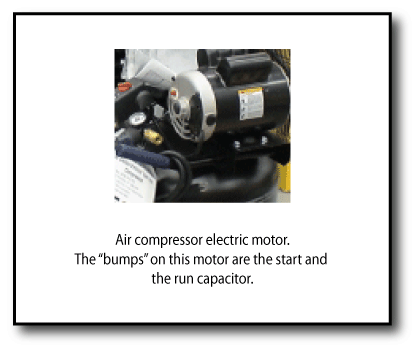This page is about how air compressors work – page two. If you have just landed on this page, page one of how air compressor work is here.
On this page we will continue our discussion about how air compressors work, and in particular, the cut in and cut out functions of the pressure switch and a bit about air compressor motors.
We now know that when the pressure in the air compressor tank drops to the pressure switch preset cut in point the compressor will start. The compressor pump will pump air into the tank, and if you are not using an air tool, or if the compressor can pump more air into the tank than you are using, the compressed air pressure in the tank will start to rise. As long as more air is going into the compressor tank than is coming out, the pressure will continue to rise in the tank until it reaches the pressure switch cut out pressure setting.

The pressure switch in the photo above is typical of those used in quite small air compressors. If you don’t have a pressure switch visible on the outside of your air compressor, it is possible that your compressor model uses an internal switch like this.
When the pressure in the tank reaches the cut out pressure setting of your pressure switch, it will trip off, power will be cut to the motor, the motor will stop, the pumping will stop, and your compressor will remain idle until, once again, the pressure in the tank drops to the cut in level, and then the cycle will repeat.
So far we have discussed…
So far we have discussed the compressor tank, the compressor pump and the compressor pressure switch. Let’s chat a bit about the compressor motor.
The air compressor motor
The smaller air compressor is frequently equipped with a 120 VAC motor. These air compressors come with a length of cord already attached to the compressor pressure switch to supply power to the motor. Plugging that cord into a typical household wall socket will power up the compressor motor, if the pressure switch has tripped to cut in.
Quick Tip: It’s better to plug your compressor into a supply circuit that has a 20 amp breaker than one with a 15 amp breaker. It is also better not to have anything else on that circuit that may try to start when your compressor is trying to start too. If you are inclined to run an extension cord to your compressor… don’t! It is best for the compressor motor to have a clean electrical supply with the shortest possible supply path to the air compressor.

It is typical of electric motors that they pull a larger amount of power when they are trying to start than when they are running.
In particular in a 120 volt supply circuit, and often in a 240 volt circuit, the motor will pull more amps when it is starting than are available in the supply circuit to the motor. If that happens, almost invariably, the fuse will blow or the breaker will pop.
Some compressor motors will still pull very close to the line in terms of power supply even when they are running.
For this reason motors come equipped with a start capacitor, a combination of a start/run capacitor, or a start and a run capacitor.
In simplest terms, a capacitor is a quick-discharge battery which builds up a charge over time while the motor is powered, and then, when the motor goes to start, the capacitor sends its charge into the start circuit to help get the motor going.

When temperatures are well above freezing, you should be able to use any 10W30 (NON-DETERGENT) oil. If temperatures fall below freezing, and the compressor is also at that temperature, you may have to move to a lighter oil, also non-detergent, but switch back to the heavier viscosity as soon as the temperature is above the freezing point. Of course, if the compressor is under warranty, use the factory recommended oil. All that information can be found here at the Puma site: pumaairusa.com/resources.html.
How do I know when (at what psi) to expect my compressor to “cut-out” or stop once I turn it on for the first time.
Don
Different air compressors have different settings. This is based on the compressor and the range between cut in and cut out is determined by the engineers when the compressor is first designed. The settings are often on a label inside the cover of the pressure switch, and also in the compressor manual. If you lack the manual, search on line for a replacement pressure switch for your make and model, and that should tell you what the parameters are for that compressor. Typically, the cut out is between 100 PSI and 150 PSI depending on the make.
So if my compressor is rated for 150 psi operations then I should be ok to let it run up to at least 150 psi before I hope it auto cuts-out?
Yes. If the cut out is 150 PSI, the compressor should stop at that tank pressure. If for any reason the pressure switch does not cut off the compressor motor, then if the tank pressure rises past that 150 PSI, typically about 10-15 PSI higher, the PRV will open to prevent an overpressurization.